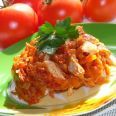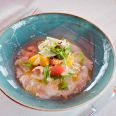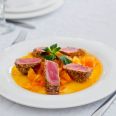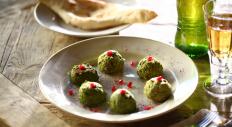Cuisine of Armenia
Today Restaurant.Ru is presenting Armenian cuisine. The Armenian cuisine, as well as the cuisines of Transcaucasia, is considerd not only exotic, but also healthy, popular and extremely delicious. Armenians like eating, but they can also cook delicious, cost-effective and extremely healthy dishes appreciated by any gourmet. Totally, the Armenian cuisine is over 2,000 years old - and it is still very young!
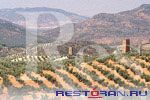
Today Restaurant.Ru is presenting Armenian cuisine. The Armenian cuisine, as well as the cuisines of Transcaucasia, is considerd not only exotic, but also healthy, popular and extremely delicious. Armenians like eating, but they can also cook delicious, cost-effective and extremely healthy dishes appreciated by any gourmet. Totally, the Armenian cuisine is over 2,000 years old - and it is still very young! What are the historical traditions of the Armenian cuisine? First of all, it is bread. By the way, in Armenian the words "to have breakfast", "to have dinner" and "to have supper" are replaced with an expression "to eat bread". Armenians eat a lot of bread, mainly lavash flatbread. A specific feature of Armenian cuisine is spiciness. The basic seasonings are pepper, garlic and various spicy herbs. The spicy seasonings are presented due to the climate and diverse mountain flora supplying eastern cuisine. Another feature is the consumption of a lot of table salt. This tradition is also deeply rooted. Salt is such a vital seasoning, that it even used to be idolized. Moreover, some Middle East peoples still use salt as a money equivalent. One of the most widespread milk products of Armenian cuisine is matsun. It is made of cow, sheep and bull milk. To make matsun, milk is brought to boil, and then chilled to the required temperature. The matsun of the previous day is used as ferment, while the milk clot formed during milk ripening is used as initial ferment. Milk is ripened at 40-45C. 4 to 6 hours later, as soon as the clot is formed, matsun is chilled to 5-8C. Matsun is used to prepare spas soup served with crushed garlic to various meat dishes. When mixed with water, matsun is a fine refreshing drink. Matsun is also whipped to make long-storing butter. As for the Armenian diet, it was and, perhaps, still is very unusual. Paradoxical, as it might seem, the main meal is lunch, or, rather, dinner. Breakfast consists of bread and cheese. Lunch includes bread, cheese, matsun or soup. All the fattest, spiciest, and hottest was eaten in the evening, during dinner which usually consisted of several dishes. Soups were served in big clay tureens, and then poured in plates. After soups, they served beef and lamb dishes, then poultry dishes, then fish dishes, and, in the end, egg dishes. In other words, the main Armenian meal is dinner. It is even convenient – you do not have to hurry, you can enjoy delicious dishes, good wine and a pleasant conversation.
Yerevan Salad
5-6 tomatoes and 5-6 cucumbers
3 sweet peppers
3-4 onions
salt, pepper
vinegar
fresh coriander, basil and parsley
Basically, it is a traditional European salad, however, the addition of spicy herbs and vinegar makes it very savoury. Besides, it is a layer salad, so it should be taken from the bottom of the salad bowl. Rinse tomatoes, cucumbers and sweet pepper. Peel cucumbers, remove the stem and the core of the sweet peppers, peel onions. Slice all vegetables into thin circles. Rinse fresh herbs and chop finely. Put the vegetables into a salad bowl in layers - tomatoes, cucumbers, and sweet pepper. Sprinkle with salt and ground pepper, put onions above, sprinkle with vinegar and chopped herbs. Leave to rest 10 to 15 minutes before serving – it will become more delicious.
Leninakan Salad
3 medium aubergines
4 tomatoes
2 sweet peppers
salt and fresh parsley
This salad is also unusual; it is very good when cooked at a summer cottage or in the nature. It is made of vegetables with spices cooked on skewers. String aubergines, sweet pepper and tomatoes on skewers and cook over red chars without flame. Peel the cooked vegetables, salt them, put in a salad bowl and sprinkle with fresh parsley. This salad is good with stewed meat dishes.
Nakhichevan Baklava
700-750g wheat flour
a little baked butter
2 eggs
40g yeast
1 cup water
Whip butter and eggs with half cup of water. Stir yeast in another half cup of water, combine with egg mix and mix pastry on this liquid. Leave the pastry for one hour in a warm place (22-25 C). Meanwhile, prepare the filling. You need 500g shelled nuts, 450g sugar, 4 teaspoons cinnamon, 8-9 capsules cardamom. Crush or grind walnuts finely, mix with sugar, cinnamon and cardamom. That is the filling. Divide the pastry into two parts and roll out. Make one part 1.5-2 mm thick, and the other 2.5 mm thick. The thicker layer should fit your baking tray, with the thinner layer a little bigger. Put the thicker layer on the buttered tray, then put the filling in a 3-5 mm layer, and then close it with the thinner layer. Pinch the edges but do not pull the bottom layer. The closed baklava should fit the tray precisely. Leave the baklava on the tray for 10 minutes, then brush with yolk. Cut into diamond-shaped pieces and put into the heated oven immediately. The temperature should be at least 200-220 C. 10-12 minutes later take baklava out, cover with melted butter, brush with egg, and put back in the oven (turn down the heat considerably). 20-25 minutes later the baklava is ready. Take it out, and pour honey along the cuts.
Barurik
for pastry:
750g flour
200g butter
300g milk
200g sugar
3 eggs
1 yolk for brushing, soda
for stuffing:
200g shelled walnuts
100g raisins
200g sugar and cinnamon
Make the pastry. Sift the flour and put it on the table shaping as a hill. Make a deepening in the hill and pour in milk with soda, melted butter, whipped eggs and sugar. Gradually collecting the flour to the middle, make soft and not very dense pastry. Roll it out and cut into six parts. Roll out each part and cut into 8 pieces. Shape each part as a square. Then prepare the filling. Grind walnuts, mix them with sugar, raisins and cinnamon. Put a little filling on each square, fold it in half, and pinch the edges to shape as a crescent. Brush the cookies with yolk and bake in the oven at 150-160C. The cookies should be of light brown colour.
Plaki
1kg fish (trout or pestrushka)
salt, pepper to taste
50g butter
red pepper
garlic
parsley
Clean and rinse fish. Cut into portion pieces and put in a buttered saucepan. Sprinkle with red pepper, crushed garlic and add a little water. Cover the saucepan with a lid and cook at low heat 20 minutes. Put the prepared fish on a dish and top with parsley.
Kutap
1kg trout
1 cup boiled rice
butter
0.5 cup raisins
1tsp ginger
breadcrumbs
Clean the trout carefully removing the inwards through the holes appearing after the gills are removed. Carefully remove the inwards with a tablespoon and we remove blood from the spine part. Rinse again. Add salt, pepper and sprinkle with lemon juice. For stuffing, mix boiled rice, raisins and ginger. Fill the belly with this mass, put the trout on a buttered tray sprinkled with breadcrumbs and bake until ready.
Amich
1.5kg chicken or turkey
0.5 cup rice
0.5 cup shelled almond
1/4 cup dried apricots
1/4 cup raisins
a little baked butter
1tsp cinnamon
4 cloves
salt and fresh herbs
Boil rice until half-ready. Fry raisins, dried apricots, shelled almond five minutes in oil, mix with rice, add baked butter, ground cinnamon and cloves. Fill chicken or turkey with the stuffing, sew it up, brush with oil, put in a deep frying pan, add half cup of hot water, and fry in oven, pouring with fat from time to time.
Pilaf "Ararat"
1.7kg rice
1kg apples
1kg quince
1 cup baked butter
1 cup raisins
100g albudalya (dried yellow plums)
dried apricots, almond, salt
To prepare pilaf pour salted water over rinsed rice and leave for 30-40 minutes. When it enlarges, put it in salted boiling water and cook until the rice is soft outside and hard inside. Then put the pilaf on a big dish as a hill. Put baked apples and quince around, and two fresh apples between them on the opposite sides of the dish. Finally put around raisins, albudalya and dried apricots, and shelled dried almond fried in oil.
Khash
1.5kg beef legs
0.5kg tripe
2-3 garlic
1 radish
fresh parsley, basil, tarragon
Well-known Armenian khash is a special dish. A lot of wonderful qualities are attributed to it, the most important being so-called sobering effect. They say, that Armenian khash is so good that even a dead-drunk person becomes sober, healthy and cheerful having eaten a plate of this soup. For this reason, all guests are treated to khash on the third day of an Armenian wedding.
Let"s cook it! First, singe, scrape and wash beef legs. Then split them into parts and soak for 24 hours in cold running water. If it is simple cold water change it every 2-3 hours. 24 hours later wash the legs again, put them in a narrow saucepan and fill with water so that its level is 15-20 cm over the legs. Put the saucepan on the heat. Khash is coked without salt. Remember that boiling should be mild. Certainly, skim it periodically. Meanwhile, prepare the tripe. Clean it, rinse, fill with cold water and boil until its specific smell disappears. Take the tripe out and rinse again, then cut it and put in the saucepan with legs. The khash is ready when the meat easily is separated from the bones. Then add the skimmed fat and serve very hot. Khash is usually served with salt, crushed garlic in broth, radish, spicy herbs and lavash flatbread that can now be bought at any shop.
Lobhashu
1 cup red beans
2 onions
0.5 cup shelled walnuts
a little flour
baked butter
salt, red pepper and coriander
Lobhashu is a soup with beans (lobi), Armenians" favourite legume. Normally they prefer red beans for soups though there are many recipes with white beans. This lobhashu is made of red beans. Select and rinse in cold water, bring to boil. Then skim it and continue cooking at low heat until ready. Ready? Then drain the beans with a colander, press through a sieve, and stir in bean broth to make even dense mass. Then add finely sliced fried onions, flour stirred with bean broth, crushed walnuts, salt, red pepper, coriander. Stir everything carefully, combine with the remaining broth and bring to boil.
Pkhali from the Chef of Kharcho Restaurant
Pkhali is one of the most popular and beloved by many people dishes of the Georgian cuisine. It is very easy to cook and there are so many variations. You may use almost any vegetables and herbs to co...
Marinated cod
There are lots of recipes to cook marinated fish. A great variety of such recipes consists of frying pieces of fish in oil. I would like to offer you a recipe of lean fish in marinade. It gets tasty, ...
Fresh sea bass carpaccio with citrus sauce
Hospitable and vivacious brand-chef of Park Giuseppe Restaurant Sergey Lasarev showed us how to cook fresh sea bass carpaccio with citrus sauce – a simple but dainty food.


